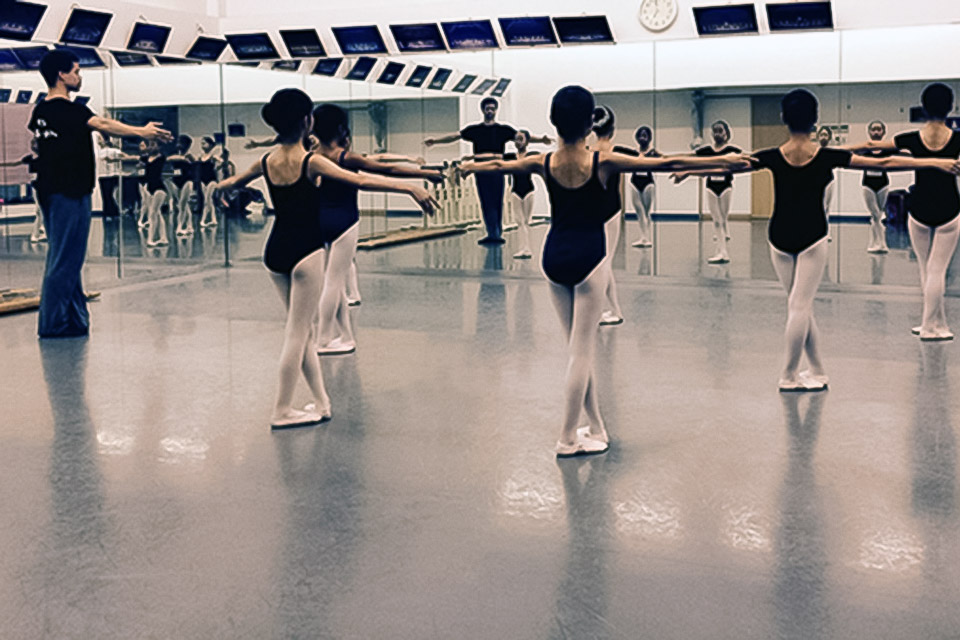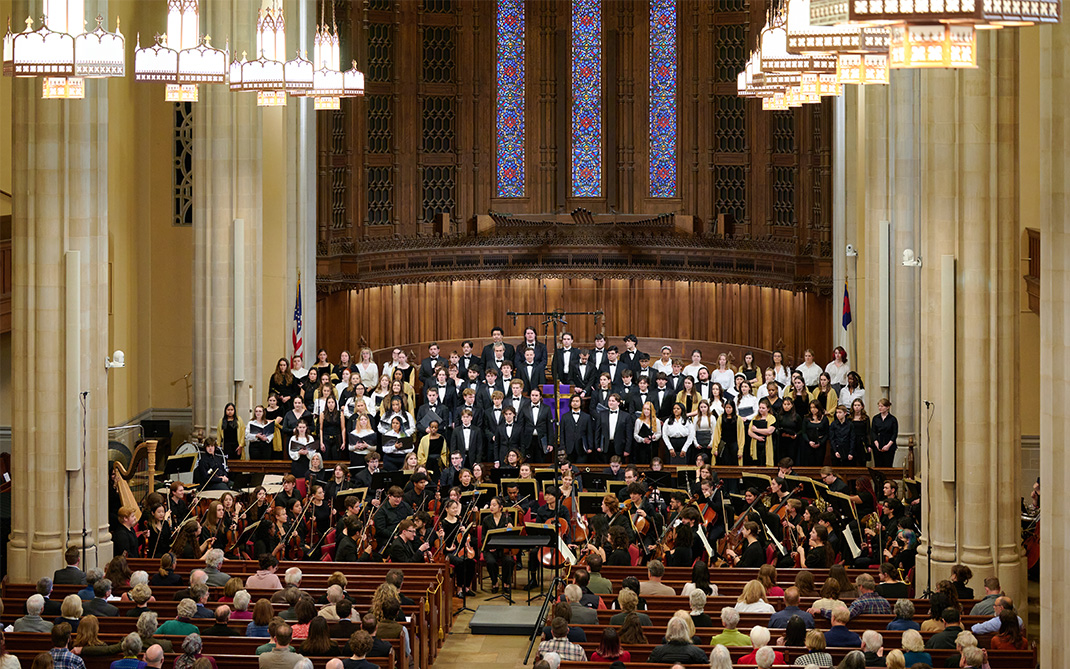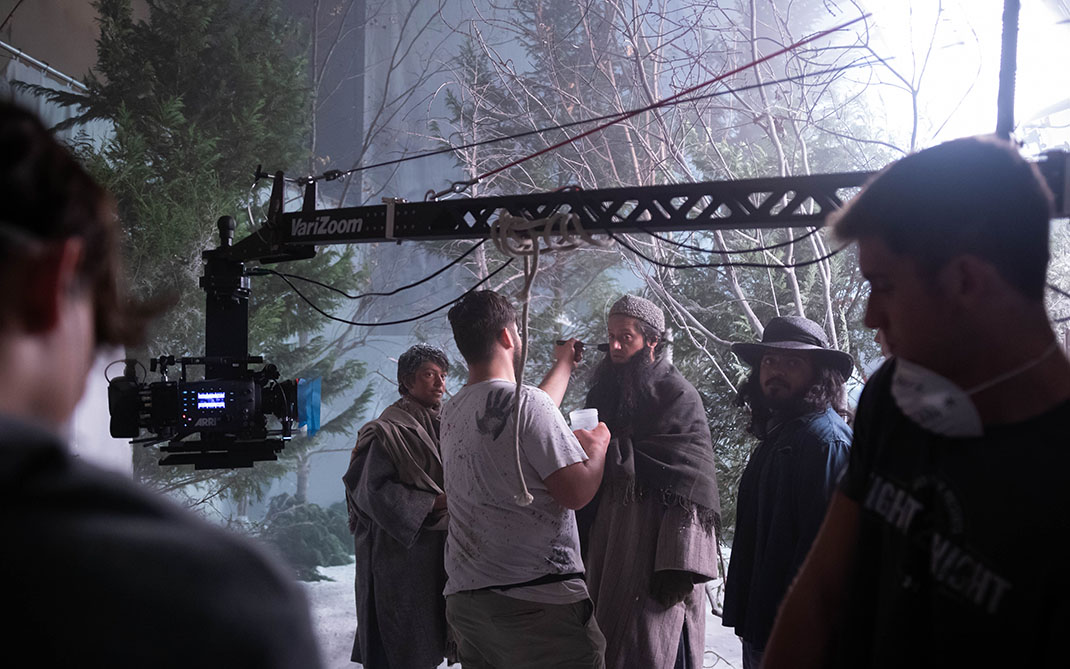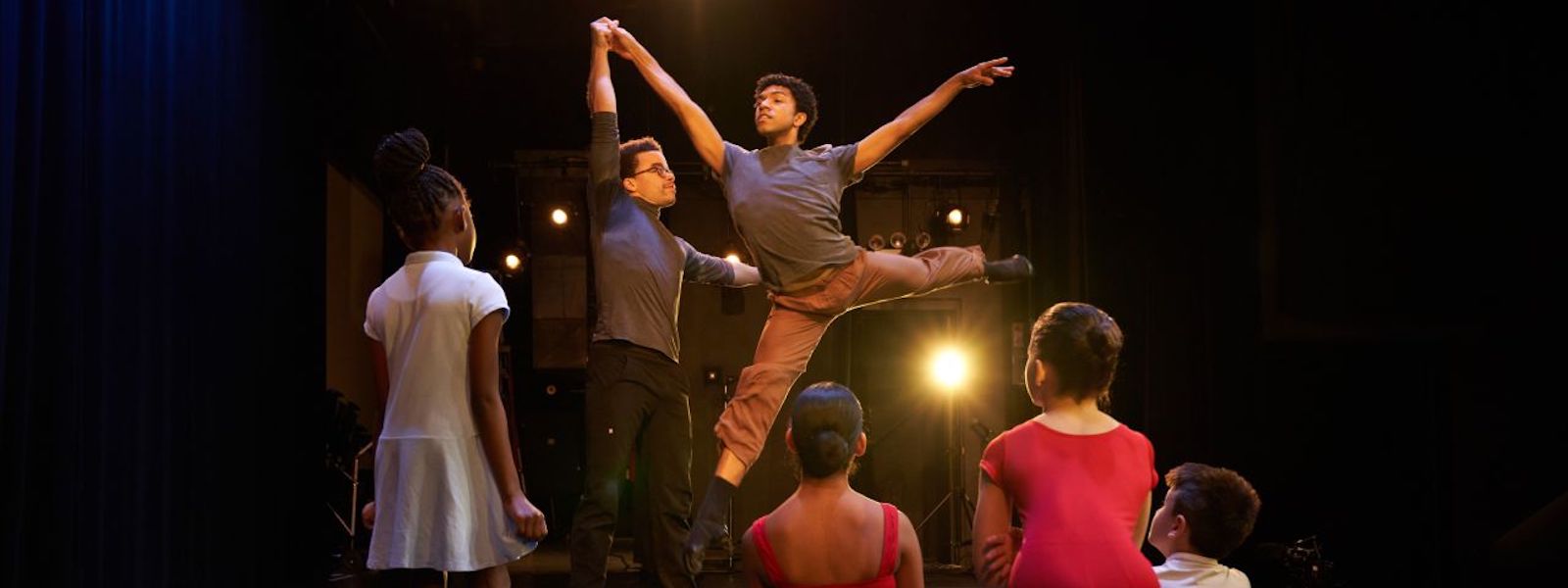Steven Melendez
The views and opinions expressed by speakers and presenters in connection with Art Restart are their own, and not an endorsement by the Thomas S. Kenan Institute for the Arts and the UNC School of the Arts. This interview has been edited for length and clarity.
In 2022, Steven Melendez was named artistic director of New York Theatre Ballet, becoming only the second person to lead the institution. In several ways, he was destined to become its next leader since his relationship with the company started when he was only seven years old and founding artistic director Diana Byer recruited him to train at NYTB’s school through the company’s LIFT scholarship program. As an adult he then went on to dance professionally with NYTB for 15 years. His dance career also included numerous international stints, including as a soloist dancer with Ballet Concierto in Buenos Aires, Argentina and as a principal dancer with the Vanemuine Theater Ballet Company in Tartu, Estonia.
In other ways, however, Steven’s rise to his current leadership position has been extraordinary, if not highly improbable. When he started studying at NYTB, Steven was living with his mother in a homeless shelter in the Bronx and would reside there for three years. Thanks to the LIFT program as well as his inborn talent, he was able to cross innumerable barriers as he traveled several times a week from the South Bronx to the rarefied world of Park Avenue and back again.
Steven’s own journey is explored in the feature documentary film “LIFT: a Journey from Homelessness to the Ballet Stage,” which was released earlier this year. The film, which spans six years, tracks Steven as he works with three young dancers in the LIFT program who, just as he himself once did, have to traverse the minefield of economic insecurity to study an artform that in ways financial, cultural and historical would have normally been completely inaccessible to them.
Here Steven candidly describes the new barriers he is having to overcome in his new role as a cultural leader and envisions how to make ballet a thrilling and relevant artform for all audiences across cultures and backgrounds.
Choose a question below to begin exploring the interview:
- You’ve been on the job a little more than a year. How has this first year gone?
- The money and therefore the power still resides in the hands of those traditional board-member circles. You’ve said you don’t know what the solution is but are you finding a way to train yourself to make those friends? How are you negotiating it?
- How do you picture your company bringing an audience along for the ride, also keeping in mind that the general American citizen doesn’t have that much free time on her hands?
- How are you both making the process more transparent for your audience and also making the product more fascinating?
- In the documentary “Lift,” you say, “I hope that Victor will be able to use his background and see where he’s different from the dancers that have come before him to see what secret weapon he has, as opposed to confronting the world in the way that I’m only now realizing I have.” Could you describe your secret weapon and how you deploy it?
- What piece are particularly looking forward to making at ABT?
Pier Carlo Talenti: You’ve been on the job a little more than a year. How has this first year gone?
Steven Melendez: My first year has been a roller coaster, is the best way I can put it. I have had a very steep learning curve, and I’ve had a lot of really exciting successes and victories and a lot of unexpected setbacks and things that didn’t go quite the way I thought they would. But I think that’s pretty typical for someone in my position.
One of the things that’s much harder than I thought it would be is fundraising, which is something I don’t have any experience in.
Pier Carlo Talenti: Had anyone told you it was going to be easy?
[They both laugh.]
Steven: No, nobody said it was going to be easy, but I figured there are plenty of people that do it in the world. Here’s what I realized actually —and maybe this is what we’ll get to talking about in a little bit — is I don’t have the pedigree of the kinds of people, the kinds of connections, the kinds of networks that are necessary to be a successful fundraiser for a nonprofit organization. And I’m realizing that perhaps that is one of the reasons why arts and dance and music and symphony and all of these things that require fundraising to stay vibrant are sort of — I’ll use this term — an old boys’ club. Or old women’s club, as it might be in the dance world. It’s really hard to make new friends, I guess is the best way to put it, and if you don’t already know the people or have the connections, it’s quite difficult to get in the door.
Pier Carlo: To make friends in that rarefied world of wealthy board members who in New York are the bulk of the fundraising community.
Steven: That’s exactly right. What I’m realizing is that a lot of those wealthy board members or donors or major givers or people in corporate institutions that hold the strings to corporate gifts know each other through maybe their college networks, of which, of course, I didn’t go to college; I was a dancer my whole life. Or they know each other through their family connections, of which, as you know, I don’t have very many family connections, having come from a very poor family. Or they know each other through the social circles that they have cultivated through their time professionally. But as a dancer, my social circles were all other dancers and choreographers, and dancers and choreographers are notoriously not wealthy people in the United States.
It’s a really interesting, difficult thing, and it’s something that I’m learning now is really what separates the administrative staff in a lot of places from the artists in those same places. I think that has a lot to do with, as I was saying before, pedigree. I don’t know the solution to that yet. I think New York Theatre Ballet is taking a sort of grassroots approach, and I’ll tell you all about that in a little bit. But grassroots only go so far. Eventually you need those handful of major gifts, major donors, people who really have access.
Pier Carlo: I love that you’ve thrown us right into this conversation. I was going to lead us gently to that point because it’s happened a lot, especially since 2020 and the Black Lives Matter movement, that a lot of largely white board members have hired artistic directors of color to take over certain performing arts institutions with the expectation that it’ll be up to them to reinvent the company and diversify it. But you bring up a very good point, which is that the money and therefore the power still resides in the hands of those traditional board-member circles.
You’ve said you don’t know what the solution is, but in this instance, are you finding a way to train yourself to make those friends? How are you negotiating it?
Steven: Yeah, I’m trying to be careful. Very, very early on, maybe it was week two of my new role, I had someone who was close to the New York Theatre Ballet organization and had been around the organization for a long time say to me sort of offhanded — and I don’t think they meant anything prejudicial or negative or pejorative by it — but they said to me, “Well, this is going to be great. What you really need to do is really tap into your tribe. You need to get your tribe on board.” And I thought, “Well, that’s an interesting choice of words.” But I think I understood what they were saying. What they were saying was that it’s time to diversify our support base, our support network. And I thought, “Great, OK, how do I go out and find essentially what they’re saying? How do I go out and find all the Black and brown people who want to support New York Theatre Ballet?”
So then I went to some other colleagues who had been around the organization for some time, and they said to me, “Well, why don’t we get in touch with Oprah?” I thought, “Oh, that’s interesting, because is the only wealthy Black person you know Oprah? I mean, that’s a little bit strange.” And I had this sort of crisis of, I guess it’s called imposter syndrome. I had this really personal crisis maybe two months into my role, trying to figure out, “What the hell am I doing? I don’t know how to solve this problem. The people around me clearly are swimming in the deep water trying to figure it out, and the advice that they’re giving me is perhaps practical but mostly not applicable.” Or so it felt at that time.
I was looking around for someone, anyone that I thought was someone who might give me the time of day to walk me through this from a position of experience like mine. And I couldn’t find anybody. Or nobody that I knew personally. And I pride myself on knowing a lot of people in the dance world. It made me so frustrated. Every person in the dance world that I knew of who was a successful person was not a person of color. That really bothered me. I couldn’t think of a single person that I could call up in my very, very, very long phone book of people that I’ve worked with who I could just say, “Hey, how do you approach this? How do you do this kind of fundraising stuff and how do you tap into these diverse fields?”
It was my fiancée who said to me, “Well, actually you do know one person.” I said, “Well, who’s that?” And she said, “Well, you know Darren Walker.” Darren Walker, of course, is the president of the Ford Foundation. He is a personally very wealthy person, but he also holds the purse strings for the Ford Foundation, one of the largest, most philanthropic organizations on the planet. He manages billions of dollars, is my guess.
I thought, “What? I can’t call Darren Walker! Are you crazy? That would be the same as trying to call Oprah. That’s just ridiculous.” But I had actually met him just a couple of months earlier at an event, and I did have his email address, so I wrote to him. I wrote just a blind email out of the blue. I wrote to him, and I said, “I’m having some trouble. I’m new in my role. Can I pick your brain for a little bit of advice?”
It was so interesting. One of the first things he said to me on the conversation that we did end up having was, “Well, how long did it take before somebody asked you to call Oprah?” And I thought, “Wow, OK. This is a real thing.” There are people who really don’t know, and the amount that they don’t know anything about how this all works makes it so that their first instinct for what the answer is, is so stereotypical that it’s been heard before.
Darren and I talked for a little bit. He gave me a lot of really great advice, and I’m really appreciative of that early … I would say mentorship, but It was really such a short thing, it would be unfair to say that. That early advice from him. And here are some things that I’ve come to realize.
The problem isn’t only that there’s a dearth of Black and brown supporters for dance. The problem is that dance isn’t trying to make itself accessible to Black and brown people, and so then therefore, of course, we don’t have new, young, hip supporters from diverse backgrounds. I think for a long time, especially classical ballet, prided itself on, built a sort of allure that was explicitly founded in the idea that it was elite and exclusive.
Pier Carlo: Absolutely.
Steven: And the people that were wealthy and supporting it, I think to some part, were supporting it because it was elite and exclusive. It’s a little bit like a stereotype. Nobody really needs that fancy car, but the rich person buys it because they know that everybody else knows that nobody else needs it. The exclusivity of it is the thing.
Pier Carlo: If you’re on the board of a prestigious ballet company, it says a lot about you societally.
Steven: Exactly. So what I think we need to do — and I’ve been really overt and explicit about this in every place that I’ve had the opportunity to speak —is to build an organization that is designed for new-to-dance audiences. I think that this is a term that I’ve invented. In fact, I think that because very early on when I started using that term, new-to-dance audiences, our grant writer at the time, she said to me, “Steven, that’s not a thing. Nobody knows what that means. You have to explain that.” She was quite upset that I was taking so many of her characters in the grant space to write in her one paragraph that she had to explain everything I was saying.
But I think this is the trick. I think we have to cultivate new-to-dance audiences, and we have to do it from the position that understands that most new audiences don’t care about the product in the way that legacy audiences care about. That’s because, I think, the legacy audiences already understand that the product is the result of the artistic process and the artistic process is really where the magic is. That’s what they’re supporting.
If we expect that new audiences, people that have never seen dance before — they don’t know anything about dance, they have no idea why they should support it — if we expect that they’re just going to come to that one show, fall in love, and then write a check, I think we have our eggs in the wrong basket. Instead, what we need to do is invite those people to see and understand everything that it took to get to the product of the final performance.
Pier Carlo: I don’t think I understand what you mean by product exactly in this context.
Steven: So in this context, the product is the performance. I think that if we distill all that dancers and choreographers and set designers and costume designers and librettists and conductors and all of the artists that work to create a new production — whether it’s a five-minute piece for some gala somewhere or a new 90-minute ballet or three-hour ballet — the product, the show itself, the night of opening night, that three hours of the performance is the product. If we expect that new audiences, people that have never seen dance before — they don’t know anything about dance, they have no idea why they should support it — if we expect that they’re just going to come to that one show, fall in love, and then write a check, I think we have our eggs in the wrong basket.
Instead, what we need to do is invite those people to see and understand everything that it took to get to the product of the final performance. They have to understand the conversations that the artists are having with each other in the room. They have to understand the blood, sweat, and tears that go into creating something. They have to understand the passion of why that particular story needs to be told, and it has to resonate with them so that by the time they get to opening night, they already love the ballet. They haven’t seen the ballet, but they already love the ballet because they know what the ballet represents. That’s a really different and unique perspective, I think, than what the dance industry generally has been operating on for a really long time.
The evidence that I have for that is going to see any major ballet company. American Ballet Theatre is a great example. Every year they put on “Swan Lake” and “Giselle” and “Romeo and Juliet,” and they do that because that’s the product that they know people like. They know that they can sell tickets for that. I don’t mean to pick on ABT — they have to do what they have to do — but most companies are like that though, if I’m honest. They do that because they know that that will fix their bottom line, their revenue number.
The work of putting on a new production with a new choreographer, a new composer and new dancers and new sets and new costumes is very expensive. Because these companies haven’t invested in bringing the audience along for the ride during the process of creating the new work, then by the time they get to the show and everything relies on that ticket-sale number, they’re stuck. They’re on a hope and a prayer that it gets a good review and that then they continue to sell tickets. I think this is where the mistake is.
Pier Carlo: How do you picture your company, for instance, bringing an audience along for the ride, also keeping in mind that the general American citizen doesn’t have that much free time on her hands?
Steven: Yeah, time is a really important thing. I’ve sort of broken down the investment that a new audience member makes in a way that includes time. It includes a couple of things. We assume that the cost for a new audience member for them from their perspective is their money, of course, the ticket price, whether it’s a $180 ticket in the orchestra of the Met or it’s a $20 ticket on the special day where there’s reduced rates. Some amount of money is involved.
There is the time. It’s two hours of their Friday night, three hours of their Friday night or their Wednesday matinee or whatever it’s going to be when they could be doing something else with that time.
And importantly, it is their social capital. They have to be OK with telling their friends, “Hey, I’m going to the ballet tonight.” Or they have to be willing to tell their friends, “Hey, why don’t you come with me to this thing? I don’t know anything about it. I’m trying it for the first time.” And you know what? If it turns out to be a bomb, then they have to reap the repercussions of their social capital being lessened in some way. People go, “Oh yeah, you invited me to that stupid ballet last week. I’m not going to do that again with you.” They take some hit for that.
These are the three things that are the cost for the new audience member. I think that we need to make all three of those things more affordable. Now, New York Theatre Ballet does that by having very low ticket prices. Our ticket prices are $30 across the board for every show all the time. I mean, the ones that we produce here in the city at least. And then of course, we have a lot of free shows and free events and things like that. So that’s one thing. And you can only negotiate with the ticket price so much. At some point we have to pay the dancers. I mean, it’s math at some point.
The time part is interesting. I try to keep our programs at an hour and a half, inclusive of intermission. That’s the same length as a movie. You go to the movie theaters; that’s not a huge investment.
And then the social capital part is the other part. I’m really interested in building and cultivating a community of audiences that are friends, that know each other, that go and feel like it’s hip and cool. We just had a season-launch party at which our host was a drag queen and our food for the event was pizza and prosecco. It was outdoors in a garden in the East Village, and we had a DJ. And at the event, zero dancing or ballet happened. It was entirely for new, young, cool hip people who don’t know anything about dance to hear about New York Theatre Ballet. And if they chose to buy a ticket later to come back to a show, that was fine too. The point of it wasn’t trying to sell them ballet at that event. That, I think, is an interesting way to combat this social capital cost.
We combine these three things, and I think we create a place that is appealing for new audiences.
Pier Carlo: So how are you both making the process more transparent for your audience and also making the product more fascinating?
Steven: I have a new program called Between the Acts. It’s essentially an audience-cultivation, community-engagement outreach program. Between the Acts are a series of events that are free to the public, and they happen in third spaces. Last year we did one or two at the local Chase Bank, literally in the bank where they have the ATM vestibule. We’ve done a handful in libraries; we’ve done some in elementary school gymnasiums; we have plans to do some in local coffee shops around New York City. The third spaces. The people aren’t coming to a theater, they’re not coming to our studio, and also we’re not going into their home, of course. That would be intrusive. We’re meeting at some convenient third space.
Pier Carlo: And they could also stumble onto you.
Steven: Exactly, and they could also stumble onto us. At these events, we teach, essentially is the best way to put it — although it’s not really teaching; it’s more like a conversation — a little bit like low-hanging fruit, a little bit about some micro-topic that is relevant to what New York Theatre Ballet is doing in that month or in those couple of weeks.
We’ve done them with choreographers, we’ll do some with composers, we’ll do some for children that are more about the story ballets that we do. We have a “Firebird” that we just did, and we read Misty Copeland’s “Firebird” book in the library, and then we did some movement exercises with these little kids that were maybe 6 or 7 years old. And then interestingly, a bunch of them came to see our performances later that weekend. But these kinds of things where we’re not teaching ... I call it a combination between a TED Talk, except without the stuffiness of a TED Talk, and being at the barbershop. This is my culture, the barbershop culture, where it’s just a bunch of guys talking. That’s what Between the Acts is, and I don’t think there’s anyone else doing anything quite like this.
I know New York City Ballet has something called Ballet Connoisseurship, during which they get really deep into the weeds and the history of —
Pier Carlo: Which right there, I have to say, and this is not to knock them, [laughing] but just “connoisseurship” —
Steven: That’s exactly right.
Pier Carlo: — already makes me kind of not want to go.
Steven: That’s exactly right. That’s exactly right. Yes. That’s exactly what I mean. You got it. That’s exactly what I mean. Yeah. There’s an element of that that at its core is ...
Pier Carlo: It smacks of elitism.
Steven: Exactly. They’ve taken what could be a great idea, and they’ve distorted it somehow to be inaccessible without even anyone knowing, without getting past the headline.
So Between the Acts, it’s like going to a barbershop. That’s the best way to describe it. And it’s designed for new-to-dance audiences. I think we already do what we can to bring the ticket prices down. We already do what we can to keep the shows at appropriate length and on the best day of the week and all that kind of stuff. But this thing of balancing the social capital investment, if we can solve that, then we can start to engage new audiences, I think. We can become more accessible, which is what my mission is, to be the most accessible dance company ever.

Steven Melendez teaches ballet; Photo: Carmella Lauer
Pier Carlo: The documentary “Lift” follows three dancers, and one of them is Victor, whom you meet in public housing and who is 10 at the beginning and 16 at the end. In the documentary, you say, “I hope that Victor will be able to use his background and see where he’s different from the dancers that have come before him to see what secret weapon he has, as opposed to confronting the world in the way that I’m only now realizing I have.” Could you describe your secret weapon and how you deploy it?
Steven: There are two things. The big one, I think, is something that’s internal. For most young people growing up in a sort of typical youth, they are presented with opportunities to succeed, to achieve, whether they’re small things or big things, whether it’s they’re told to take out the trash because that’s their chore. They take out the trash, and then they get their allowance. They’re given an opportunity to do something, they do it, and then they’re validated for having done it well. Or they’re given the hurdle of passing the SAT. They have to study and practice for years and years and years, and then they do it and then they get into college. Then they know, “OK, great, I passed the SAT. I did that.” They go into the world a little bit stronger with a little bit more confidence than they had before that.
But for other young people, those young people that approach life from deficit as a child having less means, they are also often given fewer opportunities to achieve. They have fewer opportunities available to them in all walks of life, not just fewer opportunities available to them because they don’t have money, but they have fewer opportunities for every conceivable thing. And consequently, they miss a really critical part of growing up, which is earning their own self-respect.
Pier Carlo: They don’t get a chance to experience wins.
Steven: Exactly. They don’t get a chance to experience wins. It’s exactly what I’m saying. Exactly right.
In the dance world, every child is equal in the dance studio. You teach five or six children how to do a pirouette on Tuesday, and on Wednesday when you come in and you give the same pirouette combination, if one of them falls over in the turn, they didn’t fall over because the other kids are rich or because the other kids are white or because the other kids are whatever; they fell over because they didn’t practice. That’s entirely their own work to do that, and I think the children recognize that really quickly, really, really quickly.
Then the opposite of that is true as well. They recognize, “Holy cow, I just did that pirouette. Look at me. Oh man, I just did a double today. Look at me.” And they earn their respect. They recognize that they can overcome, that they can achieve, that they can be viewed externally the same as all the other kids in the class and that they can view themselves in some way the same as all the other kids in the class. That sets a young person up for success in everything they do.
For somebody like Victor, for somebody like me, for other children coming from the Lift program and other outreach programs around the country and around the world, the way that we can go into the world knowing that we’ve already achieved so much just by virtue of existing until today, that gives a kind of confidence where no other hurdle seems insurmountable.
The external part is more to do with how the world perceives us. It’s interesting. There are a couple of things that I’ve had a repeat experience with in my life. The first one is looking at the flash of reaction on a person’s face. When I was younger, when I was a dancer — now I’m not a dancer anymore, but when I was a dancer — telling them that I was a classical ballet dancer, I could see the gears in their brains sort of go, “Wait, what? OK.” It took them off guard a little bit because I wasn’t a skinny, white, blonde ballerina girl. Maybe I didn’t fit into the mold of what they thought a ballet dancer would be.
A similar one is when I tell people that my father was gone from when I was a child. I grew up in a single-parent household. Usually that flash of reaction is a flash of almost pity or sympathy, which speaks more to their presumption of what it must mean to grow up in a single-parent household than it does to the reality of what it means growing up in a single-parent household. They assume that that means that I was missing something in some way. So anyway, these kinds of things.
Now Victor and I and other children coming through programs like this have this opportunity, if used correctly, to purposefully manipulate people’s assumptions of who they must be and then to unveil who they actually are. Just for a moment, they can come out ahead of the negotiation, I think. Maybe I’m speaking a little bit philosophically or theoretically, but I’ve seen that this is really true.
Pier Carlo: It sounds like you’re speaking about presenting yourself with an authenticity that a previous generation of, let’s say, non-white dancers might not have been able to.
Steven: That’s very concise. Yes. [Laughing] That’s what I meant to say with all of the words.
Pier Carlo: And possibly not having to go through the hassle of a whole bunch of code-switching.
Steven: The code-switching. That’s exactly right. 100% that’s exactly right. The hassle of the code-switching, but also the experience of knowing how to code-switch, I guess, is really what it comes to. That’s the advantage. The advantage is that Victor has the experience of knowing how to code-switch very successfully.
Pier Carlo: But he now also has the advantage of being able to choose whether he wants to or not?
Steven: That’s exactly right. This code-switching thing is important. I’ve told this story a couple of times, but it’s really valuable. I was only 7 or 8 years old when I was in the homeless shelter and concurrently in the ballet program, in the outreach program. The shelter was in the South Bronx in the early ’90s, which in New York City, the South Bronx in the early ’90s was really not a very interesting place to be. It was burnt-out cars and really horrible things. And the ballet studio was literally on Park Avenue. It was on Park Avenue and 31st Street in Manhattan. There couldn’t be two more juxtaposed environments.
I was just a child. I would go almost every day on the New York City subway from Hunts Point to Park Avenue. I’d get on the train, and physically, emotionally, mentally, intellectually, I was one kind of person. And when I got off the train on Park Avenue and walked a couple of blocks into the ballet studio, I was a different person. Even as a young boy — 7, 8, 9 years old — I was code-switching. I don’t think I realized that at the time. In fact, I don’t think at that time we even had that term, code-switching, but now looking back, clearly that’s what was happening.
It was so interesting to me to be able to reinvent myself, to be the kind of person that walked and belonged on Park Avenue, even if it was just for a couple of hours a day before I had to go back on the New York City subway and go 45 minutes back up to the Bronx and interact with a very different kind of environment. That kind of practice and experience makes it so that I feel comfortable anywhere on the planet. It’s like I was saying about achieving. You can’t throw me. And someone like Victor, the same. We’re comfortable no matter where you put us because we’ve had these experiences.
Pier Carlo: What piece are particularly looking forward to making at ABT?
Steven: One of the first commissions that I’ve undertaken at New York Theatre Ballet is a series of commissions called “Letters to My Father.” I had mentioned fathers earlier, and this is why. New York Theatre Ballet is commissioning a series of male dancemakers and pairing them up with some other artists. Thus far, it has been composers, but there’s also a writer on board and maybe a filmmaker and other kinds of artists, and they’re tasked with making a piece that is a letter to their father. For me, this kind of programming, this kind of piece is the kind of piece that lends itself toward being accessible to everyone because everyone has a father or a father figure. Some people have two fathers.
Pier Carlo: And everyone has something they wish they could have said to their father, especially men.
Steven: Especially men, yeah. For me, it’s about making dances about people. This is real things, not swans and fairytales and all that stuff. It’s about making dances about people and making sure that those dances are dances that people need to see now so that it’s culturally relevant and it is urgent. I say urgent in this case, in this context, because I think that the conversations between sons and fathers have a lot to do with the changing landscape of masculinity. The definition of masculinity in America, the changing landscape of the nuclear family and man’s role in the nuclear family, has to do with the conversations that we have or we should be having about the mass incarceration of Black men and how the fatherless, fatherhood, father-absenteeism is something that’s disproportionately distributed amongst the American population. All of these conversations that need to be happening now.
November 07, 2023




